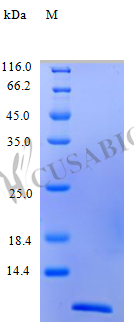Our recombinant human CCL11 protein, also known as Eotaxin, is expressed in E. coli and spans the full length of the mature 24-97aa sequence. This tag-free protein is supplied as a lyophilized powder, making it easy to reconstitute with sterile water or buffer. With a purity of >97% as determined by SDS-PAGE and HPLC, our recombinant CCL11 also boasts a low endotoxin level of less than 1.0 EU/µg, as measured by the LAL method. The protein is fully biologically active, as confirmed by its efficacy in a chemotaxis bioassay using human peripheral blood eosinophils, with an activity concentration range of 0.1-10.0 ng/ml.
C-C motif chemokine 11 (CCL11) or Eotaxin is a key protein involved in the recruitment and activation of eosinophils in response to allergens and other stimuli. CCL11 plays a significant role in allergic diseases, including asthma, atopic dermatitis, and allergic rhinitis. Hence, it is crucial to investigate the functions and mechanisms of CCL11 to develop potential therapeutic interventions for these immune-related diseases.
Extensive research has been conducted to explore the role of CCL11 in immune regulation. For instance, Ponath et al. (1996)[1] first identified CCL11 as a potent eosinophil chemoattractant. Later, Ying et al. (1999)[2] demonstrated that CCL11 was significantly upregulated in bronchial biopsies from asthmatic patients compared to non-asthmatic subjects. More recent studies have uncovered the involvement of CCL11 in other pathological conditions, such as neuroinflammation and cognitive decline in Alzheimer's disease (Villeda et al. (2011)[3]). Moreover, CCL11 has been implicated in cancer progression and metastasis, as shown in the study by Chen et al. (2019)[4], which revealed that CCL11 could promote colorectal cancer cell migration and invasion. Additionally, a study by Choi et al. (2021)[5] suggested that CCL11 may serve as a therapeutic target for treating eosinophilic esophagitis.
References:
1. Ponath PD, et al. Cloning of the human eosinophil chemoattractant, eotaxin. Expression, receptor binding, and functional properties suggest a mechanism for the selective recruitment of eosinophils. J Clin Invest. 1996;97(3): 604-12.
2. Ying S, et al. Enhanced expression of eotaxin and CCR3 mRNA and protein in atopic asthma. Association with airway hyperresponsiveness and predominant co-localization of eotaxin mRNA to bronchial epithelial and endothelial cells. Eur J Immunol. 1999;29(12): 3847-56.
3. Villeda SA, et al. The ageing systemic milieu negatively regulates neurogenesis and cognitive function. Nature. 2011;477(7362): 90-4.
4. Chen W, et al. CCL11 promotes migration and proliferation of mouse neural progenitor cells. Stem Cell Res Ther. 2019;10(1): 395.
5. Choi J, et al. Increased expression of C-C motif chemokine ligand 11 and its specific receptor, C-C motif chemokine receptor 3, in eosinophilic esophagitis: the potential role of CCL11 in eosinophilic esophagitis pathogenesis. J Allergy Clin Immunol Pract. 2021;9(4): 1584-1594.e4.






